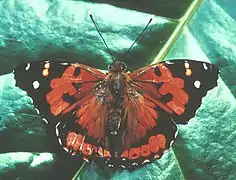Kamehameha butterfly
The Kamehameha butterfly (Vanessa tameamea) is one of the two species of butterfly endemic to Hawaii, the other is Udara blackburni.[1] The Hawaiian name is pulelehua. This is today a catch-all native term for all butterflies; its origin seems to be pulelo "to float" or "to undulate in the air" + lehua, "reddish," or "rainbow colored," probably due to the predominant color of the Metrosideros polymorpha flower: an animal that floats through the air, from one lehua to another. Alternatively, it is called lepelepe-o-Hina – roughly, "Hina's fringewing" – which is today also used for the introduced monarch butterfly.
| Kamehameha butterfly | |
|---|---|
 | |
| Scientific classification | |
| Kingdom: | Animalia |
| Phylum: | Arthropoda |
| Class: | Insecta |
| Order: | Lepidoptera |
| Family: | Nymphalidae |
| Genus: | Vanessa |
| Species: | V. tameamea |
| Binomial name | |
| Vanessa tameamea (Eschscholtz, 1821) | |
The Kamehameha butterfly was named the state insect of Hawaii in 2009, due to the work of a group of fifth-graders from Pearl Ridge Elementary.[2] These 5th graders (Robyn-Ashley Amano, Ryan Asuka, Kristi Kimura, Jennifer Loui, Toshiro Yanai and Jenna Yanke) proposed the butterfly as the state insect to various legislators as a project for Gifted and Talented.
Description
The caterpillars feed on the leaves of plants in the family Urticaceae,[3] especially those of māmaki (Pipturus albidus)[4] but also ōpuhe (Urera spp.), ʻākōlea (Boehmeria grandis), olonā (Touchardia latifolia), and maʻoloa (Neraudia spp.).[3] Adults eat the sap of koa (Acacia koa) trees.[5]
Taxonomy
It is named after the royal House of Kamehameha; the last king of this lineage, Kamehameha V, had died in 1872, a short time before this species was described. The specific name tameamea is an old-fashioned and partially wrong transcription of "Kamehameha". The Hawaiian language has no strict distinction between the voiceless alveolar plosive and voiceless velar plosive; use varies from island to island, but today, "k" is used as the standard transliteration. The voiceless glottal transition "h" is distinct and should always be pronounced - for example, "aloha" is correct whereas "aloa" is a wrong pronunciation. Thus, while "Tamehameha" would be a legitimate transcription (though considered old-fashioned on most islands), "Tameamea" is not.
References
- Oboyski, Peter T. "Kamehameha Butterfly (Vanessa tameamea)". University of California, Berkeley. Retrieved 2009-11-27.
- Cooper, Jeanne (2009-08-21). "Emblems of Hawaii a surprise to many Americans". San Francisco Chronicle.
- Scott, James A. (1992). The Butterflies of North America: A Natural History and Field Guide. Stanford University Press. p. 281. ISBN 978-0-8047-2013-7.
- Little Jr., Elbert L.; Roger G. Skolmen (1989). "Mamaki" (PDF). Common Forest Trees of Hawaii (Native and Introduced). United States Forest Service. Archived from the original (PDF) on 2009-09-18. Retrieved 2009-11-28.
- Scott, Susan (1991). Plants and Animals of Hawaii. Bess Press. p. 78. ISBN 978-0-935848-93-9.
External links
![]() Media related to Vanessa tameamea at Wikimedia Commons
Media related to Vanessa tameamea at Wikimedia Commons
- "50. Kamehameha Butterfly". Hawaii Biological Survey’s Good Guys & Bad Guys. Bernice P. Bishop Museum.
- "Hawaii's Butterflies". University of Hawaiʻi Insect Museum. University of Hawaiʻi at Mānoa. Archived from the original on 2009-09-18.